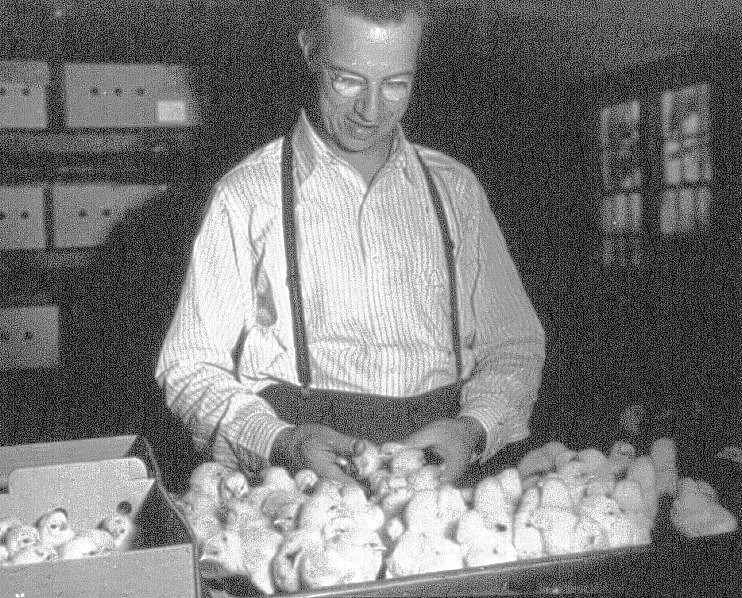Founder
Munroe Cappel Babcock founded Babcock Poultry Farm in 1935 by when he decided to start his own hatchery. It was located in a former shop in Ithaca, New York.
Munroe Babcock was born in 1907 in Fredonia, New York near the shores of Lake Erie. His father had a poultry breeding farm and hatchery in the orchard and grape district of Western New York State. His father was a mechanical engineer who started a poultry business in 1905 primarily because of his health. In 1917 the Government took over the railroads as a wartime measure and rail transport was no longer suitable to ship day old poultry from Western New York. Chickens were Munroe’s only playmates and he could tell all his father’s White Rock roosters apart by their looks and their crow. He started breeding chickens when he was 12 and continued into his college days and had a goal of being the best chicken breeder in the world. He studied poultry husbandry and breeding and agricultural economics at Cornell University graduating in 1931. His first job was the executive secretary for the New York State Poultry Breeders Cooperative and had charge of the Association that ran the Record of Performance and Certification in New York State.
In 1935 he left the Breeders Cooperative to start a hatchery in a leased building in Ithaca financed with $2,500 from his father. In the first year of operations he sold 111,000 chicks. Two years later Munroe and his wife Doris bought a farm at Krums Corners with a $2,000 loan from his mother-in-law and continued the business as Babcock’s Hatchery. They produced two children, Bruce Munroe and Carolyn Louise. Carolyn married Hans van Lier, a poultryman, who became part of the business.
When he first tried to sell chicks using a fancy printed folder that was a “bunch of lies” and did not sell a chick. From then on he was determined to tell the truth about the stock. His next catalogue was completely honest and the chicks sold like “hot cakes” and he gave a discount for cash in full with order. As a consequence of running the R.O.P. Munroe would have known the strains of Leghorns that were the better layers and this may have helped in the choice of breeders from whom he bought stock. In his advertisement (see below) in the 1942 Who’s Who in the Hatching World, published annually at the time by the International Baby Chick Association (IBCA), he states that he obtained in 1943 he stock from Dryden, Hanson, Kimber and Seidel; certainly the first three were to become renowned Leghorn breeders. Munroe was President of the New York IBCA in 1942 and was on the Board of Directors in 1943. His biographical sketch in the 1943 Who’s Who in the Hatchery World states that he was also teaching aspects of poultry production and that the hatchery had a capacity of 235,000. He entered stock in egg laying tests from 1938 until 1955 and during that time the Babcock Leghorns became one of the pre-eminent strains of layers in America. His birds set an all-time world record for laying in the egg laying tests and a number of times were acknowledged as the top laying strain in the U.S. and Canada.
Munro C. Babcock
Babcock holding the White Leghorn rooster from which every B-300 has descended. By 1975 200 million B-300’s were estimated to have been produced.
The business was selling Rhode Island Reds, New Hampshires and Barred Rocks as well as White Leghorns. In 1953 a crucial change in breeding took place to protect the Babcock “strain”. They started crossing their Leghorn lines and sold only males of one strain and females of another strain to produce a commercial cross for egg producers. In 1954 the hatchery business became very competitive. Breeders wanted hatcherymen to pay a more realistic price for their breeding stock. About 10 breeders in the U.S. and one in Canada set up franchise programs. If a hatcheryman wanted to produce and sell Babcock strain Leghorns he had to buy a “package deal”. For example, he had to buy 500 day-old male breeders to mate to his 5,000 Babcock pullets as they reached maturity. He was then producing exactly the same commercial chick that they were producing in Ithaca. In 1955 when they started the franchise program and stopped selling parent stock to hatcherymen in the Northeast and supplied that market from Ithaca. They sold parent stock to their franchises all throughout the U.S., and all over the world. In the 60’s and 70’s they took over the major share of the N.E. US with the B-300.
In 1963 Munroe started writing a weekly newsletter to all his local salesmen, all his franchise customers and their salesmen and to all Babcock people around the world. The letters were translated into Japanese, Chinese, Korean, German, Spanish and a lot of other languages. He wrote one of these letters every week for over 10 years during 1964 to 1974. He read every book on selling he could find and added this information to his own selling experience. He emphasised that although the letters were to chicken people he believed the letters would help any salesman no matter what business they operated. These letters helped Babcock become one of the largest breeders of laying stock in the world during 1964 to 1974, with sales of their own of $20 million a year and world-wide sales from franchise distributors of about $80 million a year.
Munroe C Babcock’s Business Philosophy
Munroe Babcock wrote a book published in 1984 named the “Millionaires Bible” containing “170 business secrets to put you on the road to riches”. Some of the secrets are recounted below.
How do you interest a 16 year-old boy into some day running your business?
The Babcock family owned the company until 1977 when A.H. Robins, Inc bought it. Bruce M. Babcock, son of the founder took over as President in 1964. He had had an unusual grooming for the job, a grooming that reflected the business philosophy of his father. When he was 16 he took Bruce for a trip to New York and outlined a plan for him if he wanted some day to operate Babcock Poultry Farm. He would have to do three things:
1 Graduate from college either in poultry husbandry or business management,
2 Work for some other poultry breeder or poultryman for a while,
3 Within a loan of $30,000 either he could purchase a hatchery or set up a hatchery of his own, operate his own business completely independently of his father. He started out at 23 in 1957 and set up a hatchery in Lititz, Pennsylvania in a huge vacant garage, purchased incubators from other hatcheries going out of business and hired two former Babcock employees with hatchery management and chick sales backgrounds. In seven years he had built the hatchery into the largest Babcock distributor and probably the most profitable. He returned to Ithaca in 1964 and took over as President of Babcock Poultry Farm when he was 30. He had earned the respect of the Babcock employees and the respect of all our distributors.
Munroe had this to say about training a son to take over a business: “If a son stays at home to understudy his father he is working in his shadow and remains a boy. He is still in the same environment where he played the fool on occasion. If he was his mother’s or his father’s pet he will remain so. He will not feel responsible because he will feel the whole thing was his father’s idea. And if he does not do something that must be done he will know that his father or one of the other employees will get it done.






